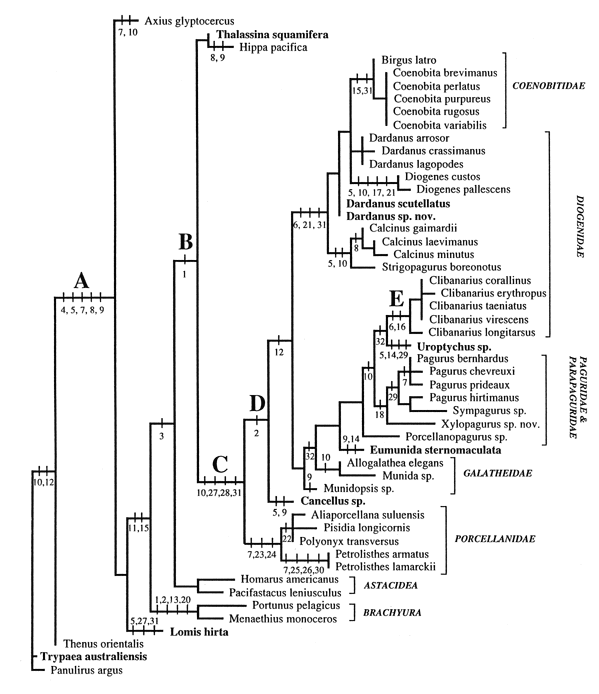Evolution & Systematics
Figure 1 shows a phylogram obtained from an analysis using 32 combined spermatozoal and spermatophore characters of 51 species of the infraorder Anomura (Tudge 1997). Results show that Clibanarius corallinus is closely related to another member in the same Genus Clibanarius erythropus (Tudge 1997). Nevertheless, results also show that the superfamily Paguroidea is not a monophyletic group and is paraphyletic with some species of the superfamily Galatheoidea (Tudge 1997). This contrasts with previous phylogenetic analyses using adult somatic morphological characters, which suggest Paguroidea is monophyletic as shown in Figure 2 (McLaughlin 1983).

(Figure 1: Phylogenetic relationship between members of the infraorder Anomura using spermatozoa and spermatophore morphological evidence from Tudge 1997).
Legend
A: Characters associated with development of the perforatorial chamber in spermatozoa.
B: Anomura-characterized by the shift of microtubular arms from the nucleus to the cytoplasm.
C: Appearance of the pedunculate spermatophore.
D: Restriction of the number of microtubular arms to three.
E: Clade of Clibanarius species separated from the other traditional diogenids.

(Figure 2: Phylogenetic relationship between families of hermit crabs (Arthropoda: Crustacea: Decopoda: Anomura) by comparing morphological characteristics between taxa from McLaughlin 1983).
Legend
1. Epistome
2. Uropodal diaresis
3. 5th Pereiopods
4. 8th Thoracic somite
5. Innervation of 1st abdominal somite
6. Antennal segments
7. Uropods and telson
8. Dactyls of 2nd pereiopods
9. Dactyls of 3rd pereiopods
10. Dactyls of 4thpereiopods
11. Ocular acicles
12. Uropodal rami
13. 4th Pereiopods
14. Pleopods(3-5)
15. Abdominal calcification
16. Abdominal development
17. Chelipeds
18.Handedness
19. 1st Abdominal somite
20. Osmoregulation
21. Antennules
22. 3rd Maxilliped
23. 2nd Maxilliped
24. 1st Maxilliped
25. Abdominal terga
26. Epistomialspine(s)
27. Pleopodal rami (female)
28. Uropods
29. Supplemental tergalcalcification
30. Carcinization
(Please refer to McLaughlin 1983 for explicit details of each character listed in the legend)
|